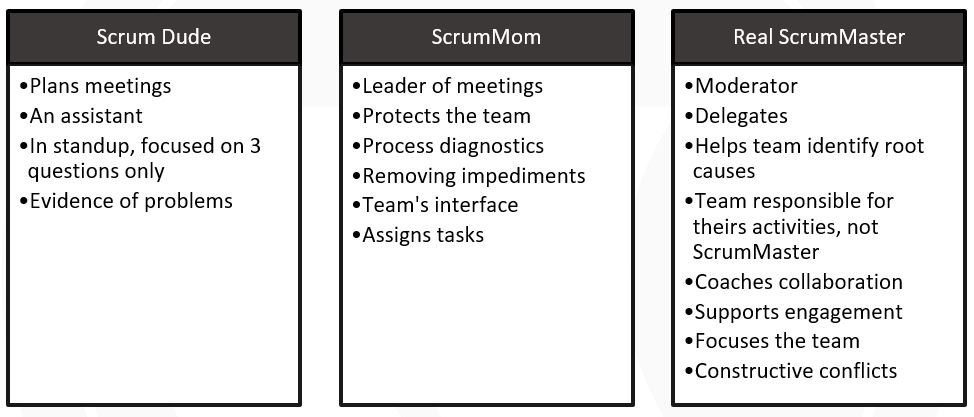 Scrum Master Role & Responsibilities
Scrum Master Role & Responsibilities
What is a role of scrum master job role? How does Scrum Master simplify the life of agile teams?
Scrum Master is accountable for removing impediments to the ability of the team to deliver the product goals and deliverables.
Scrum Master is the support of the agile team helping achieve effectiveness. She educates product owners, teams, management, and clients about agile practices.
Responsibilities of Scrum Master role
- To have an understanding of Agile and Scrum and share it with the development team.
- A leader of an introduction of Agile.
- Close collaboration with Product Owner. A supporter of the product owner.
- Facilitates team activities.
- Supports a team.
- Improving the development process and optimizing value flow.
- Removes waste.
- Identifies and removes impediments.
- Transparency and visibility.
- Coordinates work with other Scrum Masters.
- Helps identify and improve minimum agile standards and processes.
- Reporting of KPI, analysis of achievements and problems.
- Root cause analysis to improve the efficiency of the agile team.
- Coaching and mentoring of the team and the product owner.
- Improves communication in & outside of the team.
- The leader of scrum ceremonies.
- Physical and electronic board analysis.
- Helps identify and improve team rules.
- Member of Community of Scrum Masters.
- Change agent.
What Scrum Master role needs
- 50-100% capacity for scrum mastership. It is suggested to support two teams at maximum if sharing of the Scrum Master is needed.
- Scrum Master should sit with the team.
- Supported by the management to do things right.
Capabilities of Scrum Master role candidate
- The leader, not a micromanager. Prefers to pull instead of push.
- Somebody who likes to work with people and introduce changes.
- Somebody who likes to explain, present, educate.
- Patience is a must.
- As Scrum Master’s main responsibility is the team, Scrum Master must have strong soft skills.
- Knowledge of technologies, practices, and tools if Scrum Master should work with IT/tech guys. That simplifies the acceptance of ScrumMaster by the team. Deep knowledge is not necessary, the glossary at least, experiences the best.
- An understanding of business context as ScrumMaster is the right hand of the Product Owner.
Where should Scrum Master be located?
Locally with the agile team. Especially at the beginning of the Agile transformation. If your team is distributed, hire an experienced ScrumMaster who knows how to deal with such an environment. ScrumMaster must be presented in all locations on daily basis. Either physically (best), or virtually. ScrumMaster must provide equal support to all team members regardless of their location.
We prefer collocated ScrumMasters. A lot of things fly in the air. ScrumMaster as an observer must be able to recognize upcoming problems much earlier. Directly “from the air”. Without such a possibility, there will be always something surprising. ScrumMaster will react, not act proactively.
Can the ScrumMaster role rotate?
Of course. Why not? More important is to think when. New agile teams need to have the same ScrumMaster so they can deal with one change at a time. Agile introduction. Once they settle down with it, the ScrumMaster role can rotate. But don’t forget about the skillset of ScrumMaster. Choose people who want and have the skillset for Scrum mastership.
On the other side, if the team struggles a lot, rotation of Scrum Mastership can help team members to understand how tough is to be a ScrumMaster.
How many teams should Scrum Master support?
The best one. Two agile teams are possible. Three teams are hard. Four+ is impossible.
Typical mistakes
- Command & control, a push of activities.
- Assigns tasks to team members.
- He solves all problems. He doesn’t provide a transparent status of impediments.
- He doesn’t protect the team from unmanaged changes.
- He takes care much more about the process, not agile values and principles.
- He wants to increase velocity instead of a balanced work effort.
- He decides what the problem is and what isn’t.
- He doesn’t help people focus, he doesn’t limit the work in progress.
- Wants to have the fastest standup.
- High level of bureaucracy.
- He estimates and decides about it instead of the team.
What about incentives & salary?
We don’t see the role of Scrum Master as a special role. Scrum Master is not a primadonna. Responsibilities are comparable to the traditional team leader role.
In terms of incentives, we definitely prefer to think about Scrum Master’s responsibility and willingness to:
- education about Agile,
- support change of culture,
- community work in the company as an active member of Community of ScrumMasters,
- responsibility for the effectiveness of processes (time to market, cycle time, waste removing, retrospective ideas implementation),
- development of soft-skills of the agile team that ScrumMaster supports,
- product + team KPI,
- agile assessment KPI.
The development of a Scrum Master
You can’t be a great Scrum Master immediately after your certification. Expect 6-9 months of experience when Agile suddenly starts to make sense and things will fit together into a wider perspective. You have to make mistakes. You should expect your personal development in multiple stages.

Scrum Master Daily Checklist
Kanban Board
- Does the team know what has been committed?
- Is the taskboard visible?
- Is the Kanban board updated since the last stand-up?
- Is time remaining updated since the last stand-up?
- Are all stories and tasks estimated (maybe except spikes)?
- Are stories broken into tasks?
- Are all tasks which are in progress or done assigned?
Impediments
- Are impediments visible to everyone?
- Is the status of impediments updated?
- Are impediments assigned to concrete persons?
Burn Down chart
- Is the burn down chart current?
- Do you understand the current sprint status and its progress?
- Does anyone add new work to the sprint backlog?
- Are you taking an action in case you are late as soon as possible?
